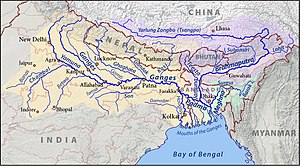
Ganges
Major river in Asia / From Wikipedia, the free encyclopedia
Dear Wikiwand AI, let's keep it short by simply answering these key questions:
Can you list the top facts and stats about Ganges river?
Summarize this article for a 10 years old
The Ganges (/ˈɡændʒiːz/ GAN-jeez; in India: Ganga, /ˈɡʌŋɡɑː/ GUNG-ah; in Bangladesh: Padma, /ˈpʌdmə/ PUD-mə)[5][6][7][8] is a trans-boundary river of Asia which flows through India and Bangladesh. The 2,525 km (1,569 mi) river rises in the western Himalayas in the Indian state of Uttarakhand. It flows south and east through the Gangetic plain of North India, receiving the right-bank tributary, the Yamuna, which also rises in the western Indian Himalayas, and several left-bank tributaries from Nepal that account for the bulk of its flow.[9][10] In West Bengal state, India, a feeder canal taking off from its right bank diverts 50% of its flow southwards, artificially connecting it to the Hooghly River. The Ganges continues into Bangladesh, its name changing to the Padma. It is then joined by the Jamuna, the lower stream of the Brahmaputra, and eventually the Meghna, forming the major estuary of the Ganges Delta, and emptying into the Bay of Bengal. The Ganges–Brahmaputra–Meghna system is the second-largest river on earth by discharge.[11][12]
| Ganges | |
|---|---|
 The Ganges in Varanasi | |
 Map of the combined drainage basins of the Ganges (yellow), Brahmaputra (violet) and Meghna (green) | |
| Etymology | Ganga (goddess) |
| Location | |
| Country | India (as Ganga), Bangladesh (as Padma) |
| Cities | Uttarakhand: Rishikesh, Haridwar
Uttar Pradesh: Bijnor,Fatehgarh, Kannauj, Hardoi, Bithoor, Kasganj, Kanpur, Prayagraj, Mirzapur, Varanasi, Ghazipur, Ballia, Lucknow (Gomti tributary), Farrukhabad, Narora Bihar: Begusarai, Bhagalpur, Patna, Vaishali, Munger, Khagaria, Katihar West Bengal: Murshidabad, Palashi, Nabadwip, Shantipur, Kolkata, Serampore, Baranagar, Diamond Harbour, Haldia, Budge Budge, Howrah, Uluberia, Barrackpore Rajshahi Division: Rajshahi, Pabna, Ishwardi Dhaka Division: Dhaka, Narayanganj, Gazipur, Munshiganj, Faridpur Chittagong Division: Chandpur, Noakhali Barisal Division: Bhola |
| Physical characteristics | |
| Source | Confluence at Devprayag, Uttarakhand of the Alaknanda river (the source stream in hydrology because of its greater length) and the Bhagirathi river (the source stream in Hindu tradition). The headwaters of the river include: Mandakini, Nandakini, Pindar and the Dhauliganga, all tributaries of the Alaknanda.[1] |
| • location | Devprayag, the beginning of the main stem of the Ganges |
| Mouth | Bay of Bengal |
• location | Ganges Delta |
| Length | 2,525 km (1,569 mi)[2] |
| Basin size | 1,999,000 km2 (772,000 sq mi)[3] |
| Discharge | |
| • location | Mouth of the Ganges (Ganges-Brahmaputra-Meghna; Basin size 1,999,000 km2 (772,000 sq mi), Bay of Bengal[3] |
| • average | 38,129 m3/s (1,346,500 cu ft/s)[4] to
43,900 m3/s (1,550,000 cu ft/s)[3] 1,389 km3/a (44,000 m3/s) |
| Discharge | |
| • location | Ganges Delta, Bay of Bengal |
| • average | 18,691 m3/s (660,100 cu ft/s)[3] |
| Discharge | |
| • location | Farakka Barrage[4] |
| • average | 16,648 m3/s (587,900 cu ft/s) |
| • minimum | 180 m3/s (6,400 cu ft/s) |
| • maximum | 70,000 m3/s (2,500,000 cu ft/s) |
| Basin features | |
| Tributaries | |
| • left | Ramganga, Garra, Gomti, Tamsa Ghaghara, Gandak, Burhi Gandak, Koshi, Mahananda, Brahmaputra, Meghna |
| • right | Yamuna, Tamsa (also known as Tons River), Karamnasa, Sone, Punpun, Falgu, Kiul, Chandan, Ajay, Damodar, Rupnarayan |
The main stem of the Ganges begins at the town of Devprayag,[1] at the confluence of the Alaknanda, which is the source stream in hydrology on account of its greater length, and the Bhagirathi, which is considered the source stream in Hindu mythology.
The Ganges is a lifeline to millions of people who live in its basin and depend on it for their daily needs.[13][14] It has been important historically, with many former provincial or imperial capitals such as Pataliputra,[15] Kannauj,[15] Sonargaon, Dhaka, Bikrampur, Kara, Munger, Kashi, Patna, Hajipur, Delhi, Bhagalpur, Murshidabad, Baharampur, Kampilya, and Kolkata located on its banks or the banks of tributaries and connected waterways. The river is home to approximately 140 species of fish, 90 species of amphibians, and also reptiles and mammals, including critically endangered species such as the gharial and South Asian river dolphin.[16] The Ganges is the most sacred river to Hindus.[17] It is worshipped as the goddess Ganga in Hinduism.[18]
The Ganges is threatened by severe pollution. This poses a danger not only to humans but also to animals. The levels of fecal coliform bacteria from human waste in the river near Varanasi are more than a hundred times the Indian government's official limit.[16] The Ganga Action Plan, an environmental initiative to clean up the river, has been considered a failure[lower-alpha 1][lower-alpha 2][19] which is variously attributed to corruption, a lack of will in the government, poor technical expertise,[lower-alpha 3] poor environmental planning[lower-alpha 4] and a lack of support from religious authorities.[lower-alpha 5]